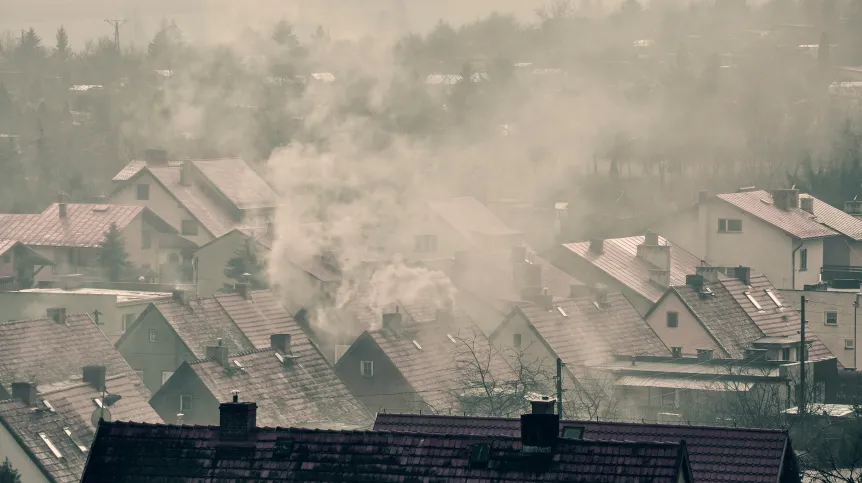
Air pollution is the fourth largest cause of premature death in the world, Dr. Piotr Dąbrowiecki from the Department of Internal Diseases, Infectious Diseases and Allergology of the Military Institute of Medicine in Warsaw told PAP. Polish research also confirms its harmful impact on health.
According to the World Health Organization (WHO), over 90 percent of the world's population lives in areas where air pollution exceeds the WHO standards.
Despite the actions taken in recent years by local governments, doctors and environmental protection specialists, the European Environment Agency reports indicate that Poland is still among the European Union countries with the highest air pollution, especially suspended particulate matter and polycyclic aromatic hydrocarbons (PAHs). In 2020, in terms of suspended particulate matter air pollution, Poland was second in the EU after Bulgaria, a year later it was first.
Meanwhile, more and more scientific studies confirm the strong negative impact of air pollution on health and its link to the risk of premature death. 'According to the Health Effects Institute report +State of Global Air 2020+, air pollution ranks fourth among the causes of premature deaths in the world - after hypertension, smoking and unhealthy diet,’ says internal medicine and allergology expert Dr. Dąbrowiecki from the Military Institute of Medicine in Warsaw. He adds that 10 years ago it was seventh in the ranking.
Polish research also provides evidence that pollution harms people's health, regardless of age, and may contribute to premature death. 'As part of the ZONE project, our team together with Professor Artur Badyda from the Warsaw University of Technology conducted a large study in two groups of children. These were 258 children from Gdynia, which is one of the Polish cities with the least polluted air, and 512 children from Zabrze, which is one of the top 20 most polluted Polish cities,’ says Dr. Dąbrowiecki.
The examined children were aged 9-15. They underwent spirometry tests, which enabled scientists to assess lung function parameters, including forced expiratory volume in one second (FEV1).
'These tests have shown that lung function differs significantly between school-age children from Gdynia and Zabrze, with children from Gdynia having 200 ml greater lung volume than children from Zabrze. Moreover, children from more polluted cities are twice as likely to suffer from allergic symptoms, such as runny nose and conjunctival symptoms - burning, redness, itching and cough,’ Dąbrowiecki. says.
He adds that this is proof that growing up in an atmosphere full of pollutants not only promotes the development of allergies, but also paves the way for asthma. 'These children have more respiratory symptoms and lower lung ventilation efficiency, which may additionally translate into a higher risk of developing chronic obstructive pulmonary disease (COPD) in adulthood,’ says Dr. Dąbrowiecki. This disease leads to respiratory failure and respiratory disability.
Another study, published in 2022 in the Journal of Clinical Medicine, analysed the impact of air pollution on mortality from various causes and on hospitalisations due to pneumonia over a 10-year period in three large urban agglomerations in Poland - in Tricity, Warsaw and Krakow.
'Our study showed that air pollution exceeding permissible standards is 24 percent responsible for increasing the risk of death from various causes, and for increasing the risk of hospitalisation due to pneumonia by as much and 75 percent,’ Dąbrowiecki says.
In another paper from 2022 ( published in the International Journal of Environmental Research and Public Health), Dr. Dąbrowiecki's team showed that an increase in PM10, PM2.5, nitrogen dioxide and sulphur dioxide pollution was associated with an increased risk of hospitalisation due to asthma exacerbation. For all pollutants (NO2, SO2, PM2.5, PM10), the risk of hospitalisation due to asthma was highest on the day of exposure, decreased below baseline values on days one and two, and then gradually increased until day six after exposure.
In one of the latest studies, published in Polskie Archiwum Medycyny Wewnętrznej ('Polish Archives of Internal Medicine') in February 2023, researchers demonstrate that air pollution with PM10, PM2.5, nitrogen dioxide (NO2) and sulphur dioxide (SO2) increases the risk of COPD exacerbation. 'In the case of particulate matter, the risk of hospitalisation increased the most on the 10th day after exposure, while in the case of exposure to nitrogen dioxide and sulphur dioxide - on the day the patient was exposed to smog,’ says Dr. Dąbrowiecki. In his opinion, this means that NO2 and SO2 have a direct, strong irritating effect on the bronchi, which intensifies the symptoms of COPD and causes severe exacerbations of the disease ending with hospitalisation.
'Our research shows how important the role of polluted air is in the initiation of various diseases, and how much it increases the risk of premature death. Unfortunately, Poland has been number one in the European Union for years in terms of air pollution with benzoapyrene, a polycyclic aromatic hydrocarbon that causes inflammation in the respiratory and circulatory systems, and stimulates cancer processes. Together with Bulgaria and Northern Italy, we are also the worst when it comes to particulate matter concentrations', says Dr. Dąbrowiecki.
He adds that particulate matter causes inflammation in various body systems. 'If it is PM10 (larger particles with a diameter up to 10 micrometers), it has a direct irritating effect on the respiratory tract - it causes a runny nose and nasal obstruction, sinusitis, nasopharyngitis and laryngitis,’ he explains. In turn, smaller particles, i.e. PM2.5 (diameter up to 2.5 micrometers) and PM1 (diameter up to 1 micrometer) penetrate the lower respiratory tract, i.e. bronchi and lungs, and irritate them, causing inflammation, which produces symptoms such as coughing, wheezing, shortness of breath, which may consequently lead to exacerbation of asthma and COPD.
The processes occurring due to irritation of the respiratory tract by particulate matter pave the way for respiratory infections, both viral and bacterial ones. Moreover, fine PM2.5 and smaller particles penetrate the bloodstream from the alveoli and directly irritate blood vessels. 'This can cause vasoconstriction and increase blood pressure, as well as trigger heart rhythm disorders. Therefore, when we have excess particulate matter pollution in the air, the incidence of heart attacks and strokes and the number of sudden cardiac deaths increase. This is also proven in Polish research by Professor Ewa Konduracka from Kraków,’ says Dąbrowiecki.
According to WHO, when we inhale polluted air, our brain ages twice as fast. This is related to the intense inflammatory process in the cerebral vessels and contributes to the more frequent occurrence of dementia syndromes such as Alzheimer's disease.
Air pollution has also been linked to the risk of cancer, including lung cancer, cancer of parenchymal organs (such as the liver or pancreas) and bladder cancer.
There is also evidence of its link to developmental disorders on the autism spectrum, including Asperger's syndrome.
'Polish research conducted by Professor Wiesław Jędrychowski also indicates that when pregnant women breathe polluted air, they give birth to children with lower birth weight, who are more likely to suffer from asthma and respiratory infections in the future. They also score lower in intelligence tests, which confirms the negative impact of pollution on the nervous system,’ says Dąbrowiecki.
A description of research on this topic can be found in the book Wpływ zanieczyszczeń powietrza na zdrowie ('The impact of air pollution on health'), by Dr. Jakub Jędrak from the Institute of Physical Chemistry of the Polish Academy of Sciences, Professor Ewa Konduracka from the Jagiellonian University Medical College, Dr. Artur Badyda from the Warsaw University of Technology and Dr. Dąbrowiecki. Its third updated edition will be released soon.
Dr. Dąbrowiecki emphasises that educating society about the impact of air pollution on the human body and investing in more ecological fuels and heating systems bring results.
'A lot has changed in places where local governments have invested in ecological education. A very positive example is Kraków, which until recently was among the leading Polish cities exposed to smog. This has now changed. It is a green island on the map of Małopolska. However, this does not apply to nearby towns that pollute Kraków,’ het says.
The change in air purity in Krakow quickly translated into improved children's health. The research conducted by Professor Ewa Czarnobilska from the Jagiellonian University shows that the percentage of children with allergy and asthma symptoms has decreased in this city in recent years. 'Kraków is a model example that change for the better is possible, but decision-makers must care about it,’ says Dr. Dąbrowiecki. (PAP)
PAP - Science in Poland, Joanna Morga
jjj/ bar/ kap/
tr. RL













